Accounting for Climate and Inherent Soil Quality in United Nations (UN) Land Degradation Analysis: A Case Study of the State of Arizona (USA)
Abstract
1. Introduction


| Inherent Soil Quality in the State of Arizona (AZ) (USA) | |||||
|---|---|---|---|---|---|
Lower  Higher Higher | |||||
| Degree of Soil Development and Weathering | |||||
| Slight (30.3%) | Moderate (69.7%) | ||||
| Entisols | Inceptisols | Aridisols | Vertisols | Alfisols | Mollisols |
| 29.3% | 1.0% | 49.4% | 2.3% | 5.1% | 12.9% |
 | 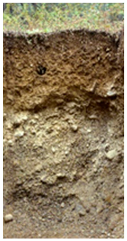 |  | 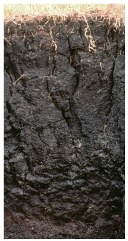 | 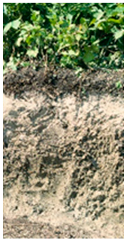 |  |
| Midpoint storage and social cost of soil organic carbon (SOC): 9.1× 1011 kg C,$152.9B | |||||
| 3.1 × 1011 kg | 1.1 × 1010 kg | 2.6 × 1011 kg | 4.5 × 1010 kg | 5.0 × 1010 kg | 2.3 × 1011 kg |
| $52.3B | $1.9B | $43.7B | $7.6B | $8.5B | $38.9B |
| 34.2% | 1.2% | 28.6 | 5.0% | 5.6% | 25.4% |
| Midpoint storage and social cost of soil inorganic carbon (SIC): 1.5× 1012 kg C,$257.6B | |||||
| 1.9 × 1011 kg | 6.4 × 109 kg | 1.0 × 1012 kg | 7.1 × 1010 kg | 2.9 × 1010 kg | 2.0 × 1011 kg |
| $31.8B | $1.1B | $174.9B | $12.0B | $4.8B | $32.9B |
| 12.3% | 0.4% | 67.9% | 4.7% | 1.9% | 12.8% |
| Midpoint storage and social cost of total soil carbon (TSC): 2.4× 1012 kg C,$411.2B | |||||
| 5.0 × 1011 kg | 1.8 × 1010 kg | 1.3 × 1012 kg | 1.2 × 1011 kg | 7.9 × 1010 kg | 4.3 × 1011 kg |
| $84.1B | $2.9B | $219.3B | $19.7B | $13.4B | $71.7B |
| 20.5% | 0.7% | 53.3% | 4.8% | 3.3% | 17.4% |
| Sensitivity to climate change | |||||
| Low | Low | Low | High | High | High |
| SOC and SIC sequestration (recarbonization) potential | |||||
| Low | Low | Low | Low | Low | Low |
2. Materials and Methods
| United Nations (UN) Sustainable Development Goal (SDG), Target, and Indicator 1 |
| United Nations Sustainable Development Goal 15. Protect, restore and promote sustainable use of terrestrial ecosystems, sustainably manage forests, combat desertification, and halt and reverse land degradation and halt biodiversity loss. |
| Target 15.3 By 2030, combat desertification, restore degraded land and soil, including land affected by desertification, drought and floods, and strive to achieve a land degradation neutral world. |
| Current Indicator 15.3.1: Proportion of land that is degraded over total land area. |
| This study—Demonstration of the importance of including inherent soil quality (SQ) for LD and LDN analyses: |
| 1. Determination of inherent soil quality (SQ) and degraded land, which is disaggregated by different types of LD (barren land, developed, agriculture), soil types, administrative units, and trends over time to determine land degradation neutrality (LDN) (Metric: area, %; Scale: local, regional, national, global; Measurement frequency: annual). 2. Damages associated with LD within the administrative unit and trends over time (Metric: loss of C sequestration potential, soil carbon (C) loss (differentiated by type: SOC, SIC, and TSC), social costs of soil carbon (C) (SC-CO2) [23]; Scale: local, regional, national, global; Measurement frequency: annual). |

3. Results
3.1. Limitations of Indicator 15.3.1 for UN SDG 15: Life on Land
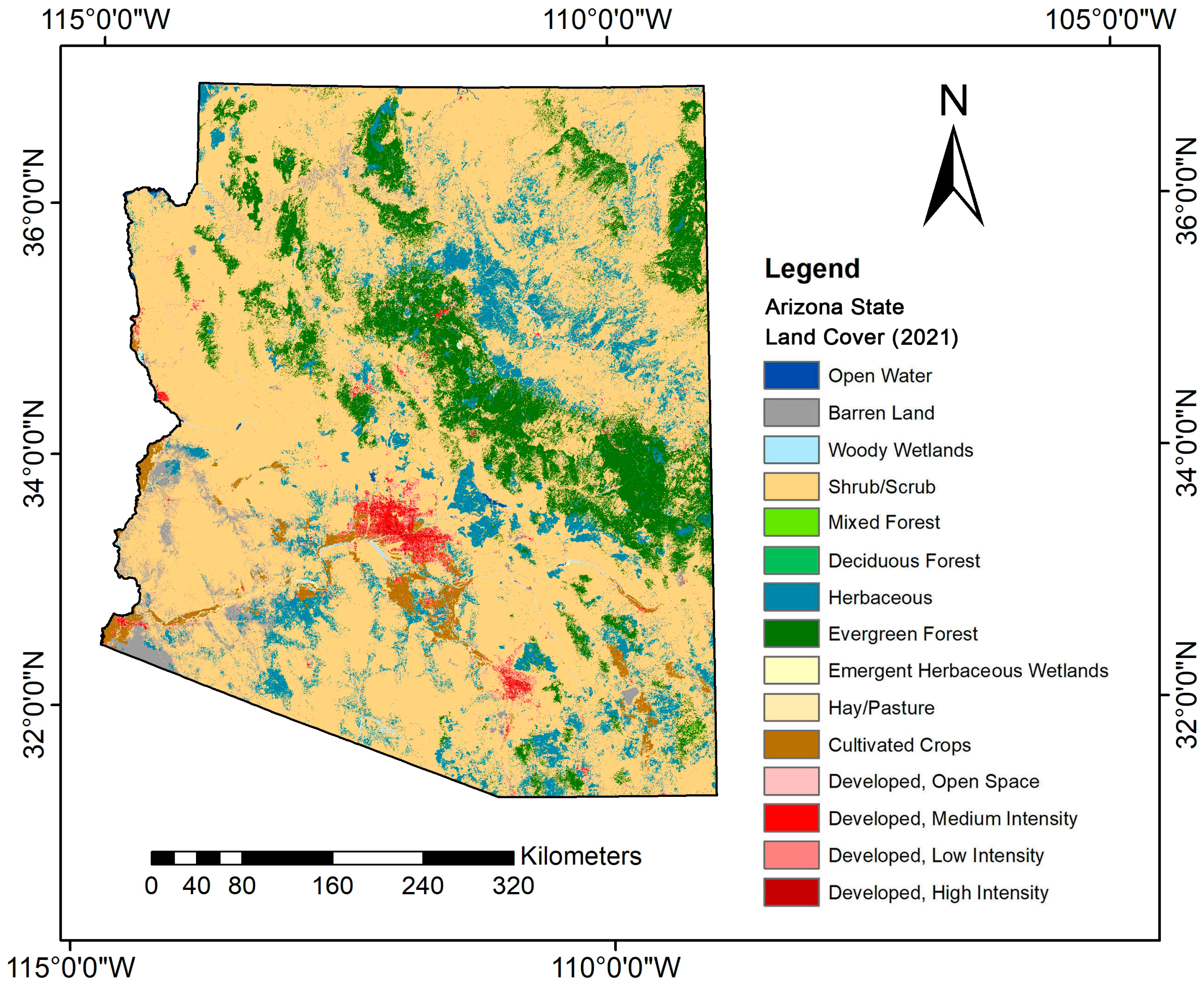
| Soil Quality Continuum | ||||||||
|---|---|---|---|---|---|---|---|---|
| NLCD Land Cover Classes (LULC), Dynamic Soil Quality (Soil Health Continuum) | 2021 Total Area by LULC (km2, %) | Inherent Soil Quality (Soil Suitability) | ||||||
Lower  Higher Higher | ||||||||
| Degree of Weathering and Soil Development | ||||||||
| Slight | Moderate | |||||||
| Entisols | Inceptisols | Aridisols | Vertisols | Alfisols | Mollisols | |||
| 2021 Area by Soil Order (km2) | ||||||||
| Woody wetlands | Higher | 541.9 (0.4) | 429.9 | 0.6 | 85.1 | 0.2 | 0.4 | 25.8 |
| Shrub/Scrub |  | 91,875.1 (69.5) | 26,932.7 | 743.7 | 50,809.2 | 2267.6 | 2479.8 | 8642.2 |
| Mixed forest | 9.6 (0.0) | 2.2 | 0.4 | 0.1 | 0.0 | 0.5 | 6.4 | |
| Deciduous forest | 35.5 (0.0) | 14.5 | 0.0 | 0.5 | 0.0 | 0.4 | 20.0 | |
| Herbaceous | 13,696.0 (10.4) | 3573.8 | 42.4 | 7836.3 | 171.2 | 281.0 | 1791.4 | |
| Evergreen forest | 14,484.3 (11.0) | 3227.7 | 439.2 | 471.5 | 612.4 | 3898.8 | 5834.8 | |
| Emergent herbaceous wetlands | 141.8 (0.1) | 100.3 | 0.1 | 16.3 | 0.3 | 1.1 | 23.8 | |
| Hay/Pasture | 69.3 (0.1) | 41.0 | 0.2 | 17.4 | 0.0 | 0.3 | 10.4 | |
| Cultivated crops | 3582.2 (2.7) | 1670.9 | 0.0 | 1598.2 | 0.0 | 0.8 | 312.3 | |
| Developed, open space | 1731.3 (1.3) | 493.7 | 14.1 | 1013.6 | 12.7 | 42.8 | 154.4 | |
| Developed, low intensity | 1310.9 (1.0) | 444.8 | 9.5 | 769.4 | 9.1 | 6.8 | 71.4 | |
| Developed, medium intensity | 1390.0 (1.1) | 490.2 | 4.9 | 811.4 | 4.4 | 4.5 | 74.5 | |
| Developed, high intensity | 430.4 (0.3) | 156.9 | 0.7 | 235.8 | 0.7 | 1.5 | 34.7 | |
| Barren land | Lower | 2840.5 (2.1) | 1198.0 | 0.8 | 1597.6 | 0.3 | 4.7 | 39.3 |
| Totals | 132,138.9 (100%) | 38,776.6 | 1256.6 | 65,262.2 | 3078.8 | 6723.4 | 17,041.3 | |

3.2. Considerations for Enhancing LD and LDN Analyses
3.2.1. Importance of Including Inherent Soil Quality (SQ) for LD and LDN Analyses: State of Arizona (AZ) (USA) as a Case Study
| Soil Order | Total Area | Anthropogenically Degraded Land | Types of Anthropogenic Land Degradation | Potential Land for Nature-Based Solutions | |||
|---|---|---|---|---|---|---|---|
| Barren | Developed | Agriculture | |||||
| (km2) | (%) | (km2) | (km2) | (km2) | (km2) | (km2) | |
| Slightly Weathered Soils | |||||||
| 40,056.6 | 30.3 | 4525.7 (+6.2) | 1198.8 (−1.7) | 1614.9 (+33.6) | 1712.1 (−6.6) | 32,491.4 (+0.7) | |
| Entisols | 38,800.0 | 29.3 | 4495.5 (+6.1) | 1198.0 (−1.7) | 1585.6 (+34.0) | 1711.9 (−6.6) | 31,704.6 (+0.7) |
| Inceptisols | 1256.6 | 1.0 | 30.2 (+12.1) | 0.8 (−43.0) | 29.2 (+14.5) | 0.2 (0.0) | 786.9 (0.0) |
| Moderately Weathered Soils | |||||||
| 92,135.3 | 69.7 | 6829.0 (+12.0) | 1641.7 (−3.4) | 3247.8 (+27.6) | 1939.5 (+4.7) | 75,920.3 (−0.3) | |
| Aridisols | 65,286.1 | 49.4 | 6043.4 (+10.9) | 1597.6 (−3.7) | 2830.2 (+28.5) | 1615.6 (+1.8) | 60,243.0 (−1.1) |
| Vertisols | 3080.3 | 2.3 | 27.2 (+30.6) | 0.3 (−5.3) | 26.9 (+31.6) | 0.0 (−97.7) | 2439.0 (−0.1) |
| Alfisols | 6723.7 | 5.1 | 61.4 (+10.1) | 4.7 (+4.5) | 55.7 (+8.5) | 1.1 (+2351.0) | 2765.4 (+12.0) |
| Mollisols | 17,045.1 | 12.9 | 697.0 (+22.0) | 39.3 (+9.0) | 335.0 (+23.9) | 322.7 (+21.7) | 10,472.8 (+1.3) |
| Total | 132,191.9 | 100.0 | 11,354.7 (+9.6) | 2840.5 (−2.7) | 4862.6 (+29.5) | 3651.5 (−1.0) | 108,411.7 (0.0) |
| Soil Quality Continuum | ||||||||
|---|---|---|---|---|---|---|---|---|
| NLCD Land Cover Classes (LULC), Dynamic Soil Quality (Soil Health Continuum) | Change in Area, 2001–2021 (%) | Inherent Soil Quality (Soil Suitability) | ||||||
Lower  Higher Higher | ||||||||
| Degree of Weathering and Soil Development | ||||||||
| Slight | Moderate | |||||||
| Entisols | Inceptisols | Aridisols | Vertisols | Alfisols | Mollisols | |||
| Change in Area, 2001–2021 (%) | ||||||||
| Woody wetlands | Higher | 4.3 | 3.2 | −1.4 | 8.8 | 22.4 | 61.0 | 6.6 |
| Shrub/Scrub |  | −0.6 | 0.8 | −1.5 | −1.6 | 0.4 | 9.5 | −2.1 |
| Mixed forest | −13.4 | −23.8 | −50.6 | −11.5 | 0.0 | −24.8 | −2.6 | |
| Deciduous forest | 1.7 | 18.1 | 0.0 | 408.3 | 0.0 | −1.5 | −9.2 | |
| Herbaceous | 5.3 | 1.1 | 40.2 | 3.3 | −5.8 | 41.2 | 21.9 | |
| Evergreen forest | −7.1 | −14.0 | −0.7 | −2.8 | −0.9 | −7.2 | −4.2 | |
| Emergent herbaceous wetlands | 6.4 | 5.5 | −11.1 | 14.7 | 13.5 | 2.1 | 4.9 | |
| Hay/Pasture | −28.5 | −21.3 | 0.0 | −25.9 | 0.0 | 4675.0 | −51.1 | |
| Cultivated crops | −0.2 | −6.2 | 0.0 | 2.2 | −97.7 | 1918.6 | 28.1 | |
| Developed, open space | 3.1 | 1.3 | −1.1 | 3.6 | −2.7 | −0.2 | 7.6 | |
| Developed, low intensity | 11.4 | 17.0 | 12.9 | 8.6 | 46.7 | 14.5 | 5.4 | |
| Developed, medium intensity | 88.5 | 91.1 | 87.7 | 88.4 | 288.3 | 136.4 | 67.0 | |
| Developed, high intensity | 169.6 | 166.2 | 189.4 | 176.5 | 1271.7 | 172.0 | 138.7 | |
| Barren land | Lower | −2.7 | −1.7 | −43.0 | −3.7 | −5.3 | 4.5 | 9.0 |

3.2.2. Considerations for Including Soil Inorganic Carbon (SIC) and Total Soil Carbon (TSC) in Land Degradation (LD) and Land Degradation Neutrality (LDN) Analyses
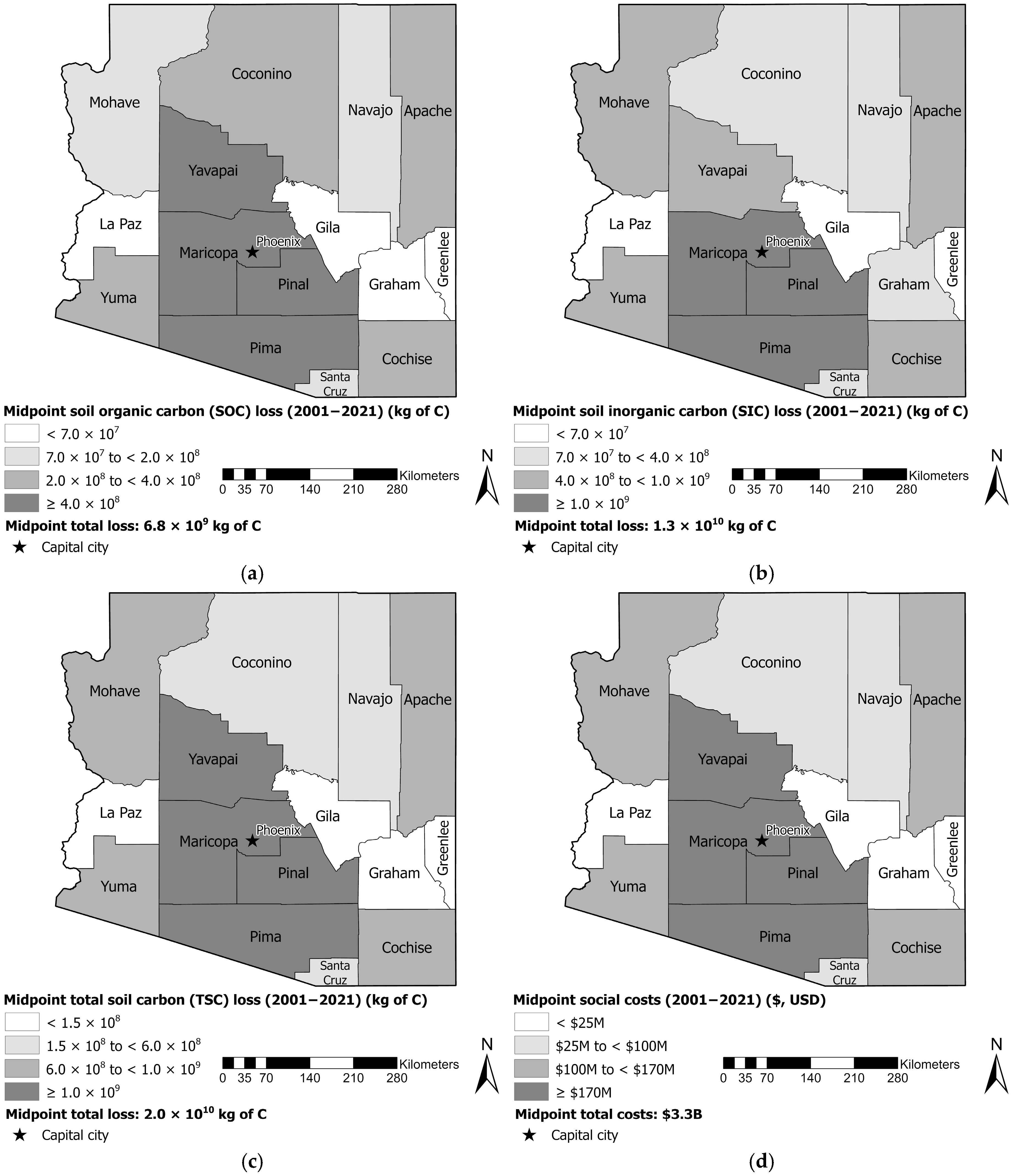
3.2.3. Considerations for Quantifying the Damages of Land Cover Change from Developments in Land Degradation (LD) and Land Degradation Neutrality (LDN) Analyses

4. Discussion
4.1. Accounting for Inherent Land Degradation and Damages from Land Degradation in United Nations (UN) Land Degradation Analysis

| Sub-indicator | Metric | Baseline Status (t0) Sub-Indicator | Reporting Period (t1) Sub-Indicator | Total Quantity of Sub-Indicator (t1) | Enhancement of Indicator 15.3.1 |
|---|---|---|---|---|---|
| Land and soil cover (results reported by land cover and soil type) | Area | ND or D | N,P,S | Area of inherently DL | Total area of IDL (t1) |
| (IDL) (t1) | Total land area | ||||
| Area | ND or D | N,P,S | Area of anthropogenically | Total area of ADL (t1) | |
| DL (ADL) (t1) | Total land area | ||||
| Area | ND or D | N,P,S | Total area of | Total area of DL (t1) | |
| DL = IDL + ADL (t1) | Total land area | ||||
| Land productivity | NPP | ND or D | N,P,S | NPP loss | NPP loss |
| Carbon stock (results reported by land cover and soil type) | SOC | ND or D | N,P,S | SOC loss/total SOC | Damages |
| SIC | ND or D | N,P,S | SIC loss/total SIC | Damages | |
| TSC = SOC + SIC | ND or D | N,P,S | TSC loss/total TSC | Damages | |
| SC-CO2 | Monetary value | N,P,S | SC-CO2 loss/total SC-CO2 | Damages |
| State | Inherently Degraded Land | Anthropogenically Degraded Land | Types of Anthropogenic Land Degradation | Potential Land for Nature-Based Solutions | |||
|---|---|---|---|---|---|---|---|
| Total Area | Barren | Developed | Agriculture | ||||
| (km2) | (%) | (%) | (%) | (%) | (%) | (%) | |
| Arizona | 132,138.9 | 71.7 | 8.6 | 2.1 | 3.7 | 2.8 | 82.0 |
| New Mexico | 254,232.5 | 63.9 | 4.0 | 0.4 | 1.5 | 2.1 | 85.1 |
| Nevada | 230,370.0 | 69.4 | 4.3 | 2.0 | 1.3 | 1.1 | 87.5 |
| Iowa | 142,833.9 | 2.1 | 88.7 | 0.1 | 6.4 | 82.2 | 2.0 |
| Illinois | 124,142.2 | 4.6 | 82.2 | 0.1 | 11.3 | 70.7 | 0.6 |
| Indiana | 82,796.8 | 10.0 | 73.3 | 0.1 | 11.1 | 62.1 | 1.0 |
4.1.1. Significance of the Results for Arizona’s Climate Change
4.1.2. Relevance of Arizona’s Results to the United Nations (UN) Sustainable Development Goals (SDGs) and Other UN Initiatives
- From 2001 to 2021, AZ had an overall area reduction of hay/pasture, affecting nearly all soil types (Table 5). This has likely caused a reduction in land available for agricultural uses, leading to a decline in food production throughout these regions. (Relevant to UN SDG 2: Zero Hunger);
- Within AZ, all of the soil orders were subject to development, which includes soils critical for agricultural and food production (e.g., Alfisols, Mollisols) (Table 5). (Relevant to UN SDG 12: Responsible Consumption and Production);
- Land degradation in AZ resulted in harm to dynamic SQ (soil health) and had worldwide climate change impacts because of soil C loss and the resulting carbon dioxide (CO2) emissions, yet no climate change plans have been completed to support adaptation and preparation for AZ (https://www.georgetownclimate.org/adaptation/plans.html (accessed on 8 August 2024) [33]. Arizona developments can be considered to be responsible for LD damages, with 4862.6 km2 of the state of AZ developed, causing midpoint losses of 8.7 × 1010 kg of total soil carbon (TSC) with the related midpoint social cost of carbon dioxide emissions (SC-CO2) of $14.7B (where B = billion = 109, $ = U.S. dollars (USD)). There was an increase (+29.5%) in the total developed area (1108.8 km2), which represents a consumptive land conversion that likely led to the midpoint loss of 1.9 × 1010 kg of TSC and a linked midpoint of $3.3B in SC-CO2. Increases in development may indicate reverse climate adaptation because the state of AZ has seen a two-degree (F) increase in temperature, along with reduced water availability related to climate change [34]. Potential land (82.0% of the total state land area) for NBS is most likely not suitable for NBS to sequester additional soil C to compensate for LD, because most of this land has inherently low-SQ soils such as Aridisols and Entisols (Table 4). This land also may not be available because 43.2% of all land in AZ is private, and the remaining is public. It is important to highlight that monetary damage estimates in this study are derived from fixed (non-market) and theoretical SC-CO2 values, which are not directly collected as damages or fines from the responsible parties. (Addressing UN SDG 13: Climate Action);
- Anthropogenic LD impacted 8.6% of land in AZ primarily due to developments (urbanization) (42.8%) and agriculture (32.2%). The state of AZ has a large proportion of Entisols (29.3%) and Aridisols (49.4%) (Table 1; Figure 2), which have low inherent SQ and can be considered as degraded land areas regardless of the type of land cover. The overall area of LD when anthropogenic LD is combined with low-inherent-SQ areas increases from the original 8.5% to 80.2% for AZ (Table 4). All six soil orders were subject to different degrees of anthropogenic LD: Entisols (11.6%), Aridisols (9.3%), Mollisols (4.1%), Inceptisols (2.4%), Alfisols (0.9%), and Vertisols (0.9%). Developments that occurred recently (2001-2021) saw a rise in the cumulative anthropogenic LD (+9.6%), and an increase of +29.5% in the developed type of LD in the state. Although there is 82.0% potential NBS land in AZ, it is often not suitable (e.g., inherently low-quality soil types: Entisols and Aridisols) and/or not available (e.g., the state is 43.2% private land) [30] (Table 4). Development reduced the overall availability of soil resources due to land cover changes between 2001 and 2021 across all 15 counties and six soil orders in AZ (Table 3 and Table S5). There were declines in the total areas of mixed forests (−13.4%), evergreen forests (−7.1%), and hay/pasture (−28.5%) land covers needed for atmospheric pollution reduction as well as C sequestration (Table 3). (Related to the UN Convention to Combat Desertification; UN Convention on Biological Diversity; UN Kunming-Montreal Global Biodiversity Framework; and UN SDG 15: Life on Land);
- Increasingly sustaining ecosystem resilience and integrity is a focus of global effort, which can be negatively impacted by LD. A key related agreement, the UN Kunming-Montreal Global Biodiversity Framework [48] was adopted at the UN’s fifteenth meeting of the Conference of the Parties (COP 15). An important goal of this framework (Goal A) was focused on maintaining, enhancing, and restoring ecosystem resilience, connectivity, and integrity and included a target (Target 11) to restore, maintain and enhance ecosystem functions and services (e.g., climate regulation, water, air, and soil health). Overall, the state of AZ potentially has 82% NBS land, which has not been impacted by development. However, this land is dominated by desert-like conditions and inherently low-SQ soils. Also, the AZ soil diversity is skewed towards Aridisols (49.4%) and Entisols (29.3%), which are inherently low-SQ soils. Our study shows that all soil orders in AZ experienced LD and were not LDN, with large increases in developments, which indicates a reduction in soil health status. This study’s methods and data analysis techniques could be leveraged to support Target 21 to improve the management of biodiversity by providing spatial data to better understand the impact of land cover change on biodiversity to improve resource governance. (Pertinent to UN Kunming–-Montreal Global Biodiversity Framework);
- The Revised World Soil Charter, endorsed by member states of the Food and Agriculture Organization (FAO), emphasizes the need to limit soil degradation in order to preserve soil ecosystem services and promote the achievement of LDN. This charter outlines guidelines to ensure that “soils are managed sustainably and that degraded soils are rehabilitated or restored” [49]. This current study reveals that AZ has experienced a rise in soil degradation and LD, as shown in Table 4, with a +9.6% rise in LD from 2001 to 2021. Land and soil degradation affected all soil types during the study period, primarily driven by an increase in development activities. This study showed that the state of AZ was not LDN, as shown by the information in Table 4. (Relevant to the Revised World Soil Charter).
5. Conclusions
Supplementary Materials
Author Contributions
Funding
Data Availability Statement
Acknowledgments
Conflicts of Interest
Glossary
| AZ | Arizona |
| B | Billion |
| BS | Base saturation |
| CO2 | Carbon dioxide |
| EPA | Environmental Protection Agency |
| GHG | Greenhouse gases |
| ICJ | International Court of Justice |
| LD | Land degradation |
| LDN | Land degradation neutrality |
| LULC | Land use/land cover |
| M | Million |
| MRLC | Multi-Resolution Land Characteristics Consortium |
| N | North |
| NBS | Nature-based solutions |
| NLCD | National Land Cover Database |
| NOAA | National Oceanic and Atmospheric Administration |
| NRCS | Natural Resources Conservation Service |
| SC-CO2 | Social cost of carbon emissions |
| SDGs | Sustainable Development Goals |
| SIC | Soil inorganic carbon |
| SOC | Soil organic carbon |
| SQ | Soil quality |
| SSURGO | Soil Survey Geographic Database |
| STATSGO | State Soil Geographic Database |
| TSC | Total soil carbon |
| UN | United Nations |
| UNCCD | United Nations Convention to Combat Desertification |
| USD | United States dollar |
| USDA | United States Department of Agriculture |
| W | West |
References
- United Nations Convention to Combat Desertification. Available online: https://www.unccd.int/convention/overview (accessed on 14 August 2024).
- United Nations (UN) Convention to Combat Desertification. Decision 3/COP.12 (COP 12, Ankara, 2015). Integration of the Sustainable Development Goals and Target into the Implementation of the United Nations Convention to Combat Desertification and the Intergovernmental Working Group Report on Land Degradation Neutrality. Available online: https://www.unccd.int/sites/default/files/sessions/documents/ICCD_COP12_4/4eng.pdf (accessed on 14 August 2024).
- United Nations (UN). Transforming Our World: The 2030 Agenda for Sustainable Development; The Resolution Adopted by the General Assembly on 25 September 2015; United Nations: New York, NY, USA, 2015; 35p. [Google Scholar]
- Sims, N.C.; Newnham, G.J.; England, J.R.; Guerschman, J.; Cox, S.J.D.; Roxburgh, S.H.; Viscarra Rossel, R.A.; Fritz, S.; Wheeler, I. Good Practice Guidance. SDG Indicator 15.3.1, Proportion of Land That Is Degraded Over Total Land Area; Version 2.0; United Nations Convention to Combat Desertification: Bonn, Germany, 2021; ISBN 978-92-95118-35-5. [Google Scholar]
- United Nations (UN) General Assembly. Resolution 68/261. Fundamental Principles of Official Statistics. Resolution Adopted by the General Assembly on 29 January 2014. Available online: https://unstats.un.org/unsd/dnss/gp/fp-new-e.pdf (accessed on 14 August 2024).
- Mikhailova, E.A.; Zurqani, H.A.; Lin, L.; Hao, Z.; Post, C.J.; Schlautman, M.A.; Shepherd, G.B. Possible integration of soil information into land degradation analysis for the United Nations (UN) land degradation neutrality (LDN) concept: A case study of the contiguous United States of America (USA). Soil Systems 2024, 8, 27. [Google Scholar] [CrossRef]
- Mikhailova, E.A.; Zurqani, H.A.; Lin, L.; Hao, Z.; Post, C.J.; Schlautman, M.A.; Brown, C.E. Disaggregating land degradation types for United Nations (UN) land degradation neutrality (LDN) analysis using the state of Ohio (USA) as an example. Earth 2024, 5, 255–273. [Google Scholar] [CrossRef]
- Mikhailova, E.A.; Zurqani, H.A.; Lin, L.; Hao, Z.; Post, C.J.; Schlautman, M.A.; Post, G.C. Spatiotemporal analysis of soil quality degradation and emissions in the state of Iowa (USA). Land 2024, 13, 547. [Google Scholar] [CrossRef]
- Mikhailova, E.A.; Groshans, G.R.; Post, C.J.; Schlautman, M.A.; Post, G.C. Valuation of soil organic carbon stocks in the contiguous United States based on the avoided social cost of carbon emissions. Resources 2019, 8, 153. [Google Scholar] [CrossRef]
- Groshans, G.R.; Mikhailova, E.A.; Post, C.J.; Schlautman, M.A.; Zhang, L. Determining the value of soil inorganic carbon stocks in the contiguous United States based on the avoided social cost of carbon emissions. Resources 2019, 8, 119. [Google Scholar] [CrossRef]
- Mikhailova, E.A.; Groshans, G.R.; Post, C.J.; Schlautman, M.A.; Post, G.C. Valuation of total soil carbon stocks in the contiguous United States based on the avoided social cost of carbon emissions. Resources 2019, 8, 157. [Google Scholar] [CrossRef]
- Soil Survey Staff, Natural Resources Conservation Service, United States Department of Agriculture. n.d.a. Soil Survey Geographic (SSURGO) Database. Available online: https://www.nrcs.usda.gov/resources/data-and-reports/soil-survey-geographic-database-ssurgo (accessed on 14 August 2024).
- Thor West, C.; Vásquez-León, M. Misreading the Arizona landscape: Reframing analyses of environmental degradation in southeastern Arizona. Hum. Organ. 2008, 67, 373–383. [Google Scholar] [CrossRef]
- Jeong, A.; Dorn, R.I.; Seong, Y.B.; Yu, B.Y. Acceleration of soil erosion by different land uses in arid lands above 10Be natural background rates: Case study in the Sonoran Desert, USA. Land 2021, 10, 834. [Google Scholar] [CrossRef]
- Jeong, A.; Dorn, R.I. Soil erosion from urbanization processes in the Sonoran Desert, Arizona, USA. Land Degrad. Dev. 2019, 30, 226–238. [Google Scholar] [CrossRef]
- Balling Jr, R.C.; Klopatek, J.M.; Hildebrandt, M.L.; Moritz, C.K.; Watts, C.J. Impacts of land degradation on historical temperature records from the Sonoran Desert. Clim. Change 1998, 40, 669–681. [Google Scholar] [CrossRef]
- Myint, S.W.; Jain, J.; Guhathakurta, S. Patterns and rates of land use land cover change: A case study of Ambos Nogales (Arizona and Sonora), 1985-2004. J. Lat. Am. Geogr. 2010, 9, 245–274. [Google Scholar] [CrossRef]
- Oerter, E.; Mills, J.V.; Maurer, G.E.; Lammers, L.N.; Amundson, R. Greenhouse gas production and transport in desert soils of the southwestern United States. Global Biogeochem. Cycles 2018, 32, 1703–1717. [Google Scholar] [CrossRef]
- Derafshi, M.; Asgari Lajayer, B.; Hassani, A.; Dell, B. Effects of acidifiers on soil greenhouse gas emissions in calcareous soils in a semi-arid area. Sci. Rep. 2023, 13, 5113. [Google Scholar] [CrossRef] [PubMed]
- Zamanian, K.; Zhou, J.; Kuzyakov, Y. Soil carbonates: The unaccounted, irrecoverable carbon source. Geoderma 2021, 384, 114817. [Google Scholar] [CrossRef]
- Soil Survey Staff, Natural Resources Conservation Service, United States Department of Agriculture. Photos of Soil Orders. Available online: https://www.nrcs.usda.gov/resources/education-and-teaching-materials/the-twelve-orders-of-soil-taxonomy (accessed on 14 August 2024).
- Soil Survey Staff, Natural Resources Conservation Service, United States Department of Agriculture. U.S. General Soil Map (STATSGO2). Available online: https://sdmdataaccess.sc.egov.usda.gov (accessed on 14 August 2024).
- EPA—United States Environmental Protection Agency, The Social Cost of Carbon. EPA Fact Sheet. 2016. Available online: https://19january2017snapshot.epa.gov/climatechange/social-cost-carbon_.html (accessed on 14 August 2024).
- United Nations Committee of Experts on Global Geospatial Information Management (UN-GGIM). The SDGs Geospatial Roadmap. Prepared by the Inter-Agency and Expert Group on the Sustainable Development Goals Indicators. Statistical Commission. Fifty-Third Session, 1–4 March 2022. Item 3(a) of the Provisional Agenda Items for Discussion and Decision: Data and Indicators for the 2030 Agenda for Sustainable Development. Available online: https://unstats.un.org/unsd/statcom/53rd-session/documents/BG-3a-SDGs-Geospatial-Roadmap-E.pdf (accessed on 14 August 2024).
- Multi-Resolution Land Characteristics Consortium—MRLC. Available online: https://www.mrlc.gov/ (accessed on 14 August 2024).
- ESRI (Environmental Systems Research Institute). ArcGIS Pro 2.6. Available online: https://pro.arcgis.com/en/pro-app/2.6/get-started/whats-new-in-arcgis-pro.htm (accessed on 14 August 2024).
- Guo, Y.; Amundson, R.; Gong, P.; Yu, Q. Quantity and spatial variability of soil carbon in the conterminous United States. Soil Sci. Soc. Am. J. 2006, 70, 590–600. [Google Scholar] [CrossRef]
- Hák, T.; Janoušková, S.; Moldan, B. Sustainable Development Goals: A need for relevant indicators. Ecol. Indic. 2016, 60, 565–573. [Google Scholar] [CrossRef]
- United Nations (UN) General Assembly. Global Indicator Framework for the Sustainable Development Goals and Targets of the 2030 Agenda for Sustainable Development; United Nations Statistics Division: New York, NY, USA, 2017; Available online: https://unstats.un.org/sdgs/indicators/indicators-list/ (accessed on 30 August 2024).
- U.S. Bureau of the Census. Statistical Abstract of the United States: 1991; U.S. Bureau of the Census: Washington, DC, USA, 1991; p. 201.
- Georgescu, M.; Moustaoui, M.; Mahalov, A.; Dudhia, J. Summer-time climate impacts of projected megapolitan expansion in Arizona. Nat. Clim. Change 2013, 3, 37–41. [Google Scholar] [CrossRef]
- UN-Habitat, U.N.S.D. SDG Indicator Metadata. 2021. Available online: https://unstats.un.org/sdgs/metadata/files/Metadata-15-03-01.pdf (accessed on 14 October 2024).
- Georgetown Law. Georgetown Climate Center. State Adaptation Progress Tracker. Available online: https://www.georgetownclimate.org/adaptation/plans.html (accessed on 10 August 2024).
- EPA—United States Environmental Protection Agency. What climate change means for Arizona. EPA 430-F-16-005. August 2016. Available online: https://19january2017snapshot.epa.gov/sites/production/files/2016-09/documents/climate-change-az.pdf (accessed on 10 August 2024).
- Zhang, Y.; Hernandez, M.; Anson, E.; Nearing, M.A.; Wei, H.; Stone, J.J.; Heilman, P. Modeling climate change effects on runoff and soil erosion in southeastern Arizona rangelands and implications for mitigation with conservation practices. J. Soil Water Conserv. 2012, 67, 390–405. [Google Scholar] [CrossRef]
- Ebi, K.L.; Vanos, J.; Baldwin, J.W.; Bell, J.E.; Hondula, D.M.; Errett, N.A.; Hayes, K.; Reid, C.E.; Saha, S.; Spector, J.; et al. Extreme weather and climate change: Population health and health system implications. Annu. Rev. Public Health 2021, 42, 293–315. [Google Scholar] [CrossRef]
- Vanhala, L.; Hestbaek, C. Framing climate change loss and damage in UNFCCC negotiations. Glob. Environ. Polit. 2016, 16, 111–129. [Google Scholar] [CrossRef]
- United Nations. Paris Agreement. 2015. Available online: https://unfccc.int/sites/default/files/english_paris_agreement.pdf (accessed on 5 April 2024).
- UN Climate Press Release. COP27 Reaches Breakthrough Agreement on New “Loss and Damage” Fund for Vulnerable Countries. 20 November 2022. Available online: https://unfccc.int/news/cop27-reaches-breakthrough-agreement-on-new-loss-anddamage-fund-for-vulnerable-countries (accessed on 5 April 2024).
- Bhandari, P.; Warszawski, N.; Cogan, D.; Gerholdt, R. What is “Loss and Damage” from Climate Change? 6 Key Questions, Answered. World Resources Institute. 2022. Available online: https://www.wri.org/insights/loss-damage-climate-change (accessed on 5 April 2024).
- Owens, S. Climate change action in Arizona. UCLA J. Environ. Law Policy 2009, 27, 317. [Google Scholar] [CrossRef]
- Olgun, R.; Cheng, C.; Coseo, P. Nature-based solutions scenario planning for climate change adaptation in arid and semi-arid regions. Land 2024, 13, 1464. [Google Scholar] [CrossRef]
- Sierra Club and other NGOs, 2023 Environmental Priorities for the Arizona Legislature and Governor. Available online: https://www.sierraclub.org/sites/www.sierraclub.org/files/2023-01/20230102b_Environmental_Priorities_for_Arizona_in_2023.pdf (accessed on 14 October 2024).
- Arizona Senate Bill 1195, State of Arizona Senate, 56th Legislature, Second Regular Session. 2024. Available online: https://www.azleg.gov/legtext/56leg/2R/bills/SB1195S.pdf (accessed on 14 October 2024).
- Evans, H. Arizona Lawmaker Calls Climate Research ‘Anti-God’, Pushes to Ban it at State Universities, Arizona Republic, 13 March 2024. Available online: https://www.azcentral.com/story/news/local/arizona-environment/2024/03/13/arizona-lawmakers-consider-bill-that-would-ban-climate-research-plans/72898105007/ (accessed on 14 October 2024).
- Reese, B. State obligations to protect the climate system. Ariz. J. Environ. Law Policy 2023, 14, 1. [Google Scholar]
- UN Convention on Biological Diversity. Treaty Collection. 1992. Available online: https://www.cbd.int/doc/legal/cbd-en.pdf (accessed on 10 April 2024).
- UN Convention on Biological Diversity. Kunming-Montreal Global Biodiversity Framework. 2022. Available online: https://www.cbd.int/article/cop15-final-text-kunming-montreal-gbf-221222 (accessed on 10 April 2024).
- Food and Agriculture Organization (FAO). Revised World Soil Charter. Available online: https://www.fao.org/fileadmin/user_upload/GSP/docs/ITPS_Pillars/annexVII_WSC.pdf (accessed on 16 August 2024).
Disclaimer/Publisher’s Note: The statements, opinions and data contained in all publications are solely those of the individual author(s) and contributor(s) and not of MDPI and/or the editor(s). MDPI and/or the editor(s) disclaim responsibility for any injury to people or property resulting from any ideas, methods, instructions or products referred to in the content. |
© 2024 by the authors. Licensee MDPI, Basel, Switzerland. This article is an open access article distributed under the terms and conditions of the Creative Commons Attribution (CC BY) license (https://creativecommons.org/licenses/by/4.0/).
Share and Cite
Mikhailova, E.A.; Zurqani, H.A.; Lin, L.; Hao, Z.; Post, C.J.; Schlautman, M.A.; Post, G.C.; Shepherd, G.B. Accounting for Climate and Inherent Soil Quality in United Nations (UN) Land Degradation Analysis: A Case Study of the State of Arizona (USA). Climate 2024, 12, 194. https://doi.org/10.3390/cli12120194
Mikhailova EA, Zurqani HA, Lin L, Hao Z, Post CJ, Schlautman MA, Post GC, Shepherd GB. Accounting for Climate and Inherent Soil Quality in United Nations (UN) Land Degradation Analysis: A Case Study of the State of Arizona (USA). Climate. 2024; 12(12):194. https://doi.org/10.3390/cli12120194
Chicago/Turabian StyleMikhailova, Elena A., Hamdi A. Zurqani, Lili Lin, Zhenbang Hao, Christopher J. Post, Mark A. Schlautman, Gregory C. Post, and George B. Shepherd. 2024. "Accounting for Climate and Inherent Soil Quality in United Nations (UN) Land Degradation Analysis: A Case Study of the State of Arizona (USA)" Climate 12, no. 12: 194. https://doi.org/10.3390/cli12120194
APA StyleMikhailova, E. A., Zurqani, H. A., Lin, L., Hao, Z., Post, C. J., Schlautman, M. A., Post, G. C., & Shepherd, G. B. (2024). Accounting for Climate and Inherent Soil Quality in United Nations (UN) Land Degradation Analysis: A Case Study of the State of Arizona (USA). Climate, 12(12), 194. https://doi.org/10.3390/cli12120194








